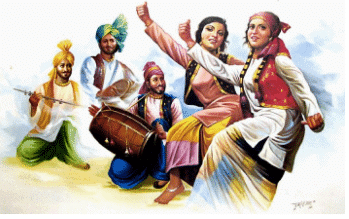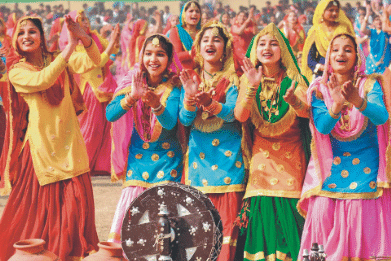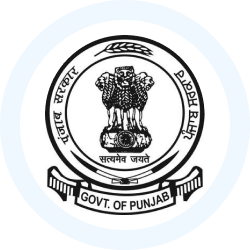PPSC PCS (Punjab) Exam > PPSC PCS (Punjab) Notes > Punjab State (PPSC) PSC: Preparation > Folk Dances and Dramas of Punjab
Folk Dances and Dramas of Punjab | Punjab State (PPSC) PSC: Preparation - PPSC PCS (Punjab) PDF Download
| Table of contents |

|
| Folk Dances of Punjab |

|
| Folk Dances of Males |

|
| Folk Dances of Females |

|
| Folk Dances of Both Males and Females |

|
| Folk Dramas of Punjab |

|
Folk Dances of Punjab
Punjabi folk dances exhibit a wide range of energy levels, from very high to low. There are distinct styles of dance for men and women in Punjabi folk traditions. Some dances are secular, while others are performed in religious contexts. These dances are typically showcased during times of celebration, such as harvests, weddings, melas (fairs), and festivals.

Types of Folk Dances:
- Male-Only Dances: Some forms of folk dance in Punjab are exclusively performed by males.
- Female-Only Dances: Similarly, there are dances that are performed solely by females.
- Joint Dances: There are also forms of dance that involve both males and females performing together.
Folk Dances of Males
Bhangra, Jhumar, Julli, Luddi, and Malwai Giddha are the well-known folk dances performed by males in the state. Here’s a brief overview of each dance:
Bhangra
- Origin: Bhangra originated as a folk dance in Punjab during the harvest festival of Baisakhi but has since evolved to be performed on various occasions.
- Performance: While traditionally a group dance, Bhangra can also be performed by a single dancer.
- Attire: In traditional Bhangra, men typically wear a lungi (a type of sarong) and a kurta (a long shirt).
- Dance Style: Dancers move in circles, clapping their hands and waving colorful handkerchiefs. In rural areas, people often gather around large drums (dhol) while performing Bhangra. The dance is a vibrant mix of high-energy steps, songs, and instruments like the dhol, iktar, and chimta.
- Sub-Forms of Bhangra: Dhankara, Dhamal, and Gatka are popular sub-forms of Bhangra, each with its unique characteristics:
Dhankara Dance:
- Meaning: The name 'Dhankara' comes from 'daang,' meaning a stick.
- Performance: Dancers form a circle and use sticks of various colors. This dance is often seen at wedding processions and resembles the dandiya dance of Gujarat.
- Costumes: No specific costumes are required, but dancers may tie a band around their waist.
Dhamal Dance:
- Description: Dhamal is similar to Bhangra, where men form a circle and dance joyfully to the dhol's beats, raising their hands in the air.
- Occasions: This dance is performed at weddings, religious events, harvest festivals, and high-profile parties.
Gatka Dance:
- Overview: Gatka is a Sikh martial art form included in Bhangra, involving the use of swords, daggers, and sticks.
- Origin: The dance, also known as Khatka or Sword dance, is believed to have been initiated by Guru Har Gobind Singh Ji after the martyrdom of Guru Arjan Dev Ji.
- Participants: The dance includes children and adults, particularly from the Khalsa Sikh community.
- Occasions: Gatka is typically performed on special occasions like Baisakhi and Gurpurb.
Julli Dance
- Origin: The Julli dance has its roots among Muslim holy men and is a religious dance associated with pirs (spiritual leaders) and recluses (monks).
- Performance Venue: This dance is typically performed in hermitages known as khanqahs.
- Dance Posture: The Julli dance is usually performed in a sitting posture, although a single dancer can also perform it.
- Dance Props: Dancers hold a thick stick in their hands and dance by revolving it. The dance involves spinning the stick while performing the dance.
- Attire: Dancers commonly wear black clothes during the performance.
- Followers' Participation: Sometimes, murids (followers) of the pirs also participate by tying ghungroos (jingling bells) around their waists, similar to Bhangra dancers.
Jhumar Dance
- The Jhumar dance has its roots in Sandalbar, which is now part of Pakistan, and is believed to have originated in the regions of Balochistan and Multan. There are various types of Jhumar, including Sutlej Jhumar, Chenab Jhumar, Beas Jhumar, and Multani Jhumar. This dance is a popular folk tradition in Punjab, characterized by its graceful movements and enthusiastic spirit.
- In the Jhumar dance, a drummer sits in the center while dancers form a circle around him, dancing joyfully. The Jhumar dance is a celebration of human happiness and is performed exclusively by local men during fairs, weddings, and major festivals. It is enjoyed by people of all ages and backgrounds, including locals and tourists.
Luddi Dance
- Luddi dance is a traditional Punjabi folk dance that symbolizes victory and is commonly found in the regions along the banks of the Sutlej River in Pakistan. Dancers in this form of dance showcase unique head movements, covering their faces with one hand while placing the other hand on their back, and perform snake-like movements.
- The dance begins when the drummer, seated in the center, starts beating the drum, prompting the dancers to join in with great enthusiasm. The attire of the dancers typically includes a loose shirt paired with a loincloth. Luddi dance is renowned for its grace and is widely popular in Punjab.
- Luddi dance has its origins in the village of Chattha, located in the Sangrur district of Punjab's Malwa region. It is closely associated with several districts, including Muktsar, Bathinda, Faridkot, Sangrur, Firozpur, Mansa, and Patiala. Initially known as Babeyan da Giddha because it was performed by elderly men (Babey), younger men also partake in this dance now. The dance involves playful teasing of others through Boliaan, which is a form of folk poetry. Traditional instruments used in Malwai Giddha include tumbi, chimta, kato, and sapp.
Folk Dances of Females
Giddha
- Giddha is a traditional dance form performed by Punjabi women during special occasions such as weddings, the birth of a son, and festivals like Teeyan. In this dance, young girls dress in colorful attire, including bright kameez, salwars, and duppattas. The embroidered duppattas and heavy jewelry add to the vibrancy of the performance. One girl plays the drum or dholki while others form a circle, clapping their hands and striking palms with neighboring participants to create rhythm. Giddha includes singing bolis, accompanied by instruments like the dholak, gharah, and clapping. When performed at weddings, it is known as Viyahula Giddha.

Jaago
- Jaago is a dance form integral to Punjabi marriage ceremonies, welcoming the bride to her husband's home. Girls dance through village streets carrying a pot (gaggar) adorned with lit candles while singing Jaago songs, which often have social and teasing themes aimed at elders.
Kikli
- Kikli is a beautiful dance performed by women in pairs. The dancers cross their arms, hold each other's hands in a crossed manner, and move in a circular motion energetically while singing folk songs. This dance is especially popular among young girls and involves clapping to various songs.
Sammi
- Sammi is a traditional dance originating from the tribal communities of Punjab, particularly popular in Sandalbar (now in Pakistan). It is performed by women of Baazigars, Rai Sikhs, Lobanas, and Sansi tribes. The dance was originally performed by Princess Sammi of Marwar to express her feelings of separation from her Rajkumar, Sach Kumar of Rajasthan. In Sammi, dancers stand in a circle, swinging their hands from the sides to chest level, clapping in rhythm, and bending forward while clapping. The dancers wear bright-colored kurtas and flowing skirts called lehengas.
- Phul Chowk is a unique silver hair ornament linked to a specific dance. In this dance, the dancer's hair is braided, and at the top of the head, there is a domed ornament resembling an inverted lotus. This ornament is called phul-chowk or suggiphul. The dance does not require any musical instruments for accompaniment. Instead, the rhythm is maintained by the dancer's foot stomping and clapping. The style of this dance is quite similar to giddha.
Folk Dances of Both Males and Females
Karthi:
- Karthi is a traditional dance performed by both men and women, usually during the harvest season. The dance begins with prayers to the deity and involves participants forming a circle by joining hands while singing sentimental songs about past victories and battles. The rhythm starts off slow and gradually picks up. The main instrument used in this dance is the Shenai.
Jindua:
- Jindua is a dance that revolves around the theme of love and is performed by a male and female pair. The dance showcases the deep affection between the partners and conveys messages about life. Participants wear colorful traditional Punjabi attire, with men donning turbans and kurtas, while women wear long ghagra cholis and head cloths. The vibrant colors and the love expressed in their songs make this dance a captivating sight.
Folk Dramas of Punjab
Baba Balak Nath Lila
- Baba Balak Nath is revered as a super-being endowed with spiritual powers, particularly in the Jalandhar Doab region. His life and the saintly values he embodies are portrayed on stage through a combination of music, song, and dance. The dramatic activities depict his virtuous deeds, known as "lilas," showcasing his profound spiritual significance.
Bhands
- Bhands are traditional entertainers in Punjab, and their profession revolves entirely around providing entertainment. They are often invited to events or spontaneously join in during weddings, where they create a lively atmosphere filled with fun and dance. Their music and dance are characteristic of Punjabi culture, and they also engage the audience with humorous dialogues and jokes.
Guru Balmik Lila
- The life of Guru Balmiki is portrayed in a heartfelt and dramatic way through this lila. It showcases the significant events of his life expressed through dance, music, and song.
- This lila is a relatively recent tradition, and the Rasdharis from the Jalandhar Doab region are particularly famous for their dramatic performances of it.
Guru Ravi Das Lila
- This lila illustrates the spiritual teachings and message of Guru Ravi Das’s life. It portrays the injustices faced by Guru Ravi Das, his unwavering faith and love for God, and the great honor he eventually received, all depicted with a sense of surrender.
- Similar to the Guru Balmik Lila, this performance is also carried out by Rasdharis and is commonly seen in nearly every city of Punjab, especially during the celebrations of Guru Ravi Das’s birthday.
Naqals
- Naqals are a form of art that involves imitation in a way that provokes intense laughter. This performance art reflects life through exaggerated and humorous depictions. Naqals showcase their talent through rigorous conservation efforts, highlighting their commitment to preserving this unique art form.
Ram Lila
- Ram Lila is inspired by the great epic, the Ramayana, and its version penned by Tulsidas known as the Ram Charitmanas. In Punjab, Ram Lila portrays the life of Lord Rama with authentically dressed characters. Sometimes, multiple episodes are staged simultaneously, such as the abduction of Sita from Asok Vatika and the battle between Ram and Ravana.
- The performance culminates with the burning of effigies of Ravana, Meghnaad, and Kumbhkaran, symbolizing the victory of good over evil. Ram Lila is celebrated with great enthusiasm in all cities of Punjab, reflecting the cultural significance of this epic tale.
Prahlad Lila
- Rasdharis, a type of traditional dance, respectfully dramatize the life story of Bhagat Prahlad. They portray his experiences through imitation and keep the audience engaged with songs and music. Despite enduring various tortures, Bhagat Prahlad remains steadfast in his faith in God. The performance ultimately conveys the message of truth prevailing over evil.
Swang
- Swang is a form of song-drama performed on an open platform, depicting the life of a renowned personality. In Punjab, popular Swangs include those of Puran Nath Jogi, Gopi Nath, and Veer Hakikat Rai. The Swangs of Puran Nath Jogi and Gopi Nath emphasize the theme of detachment, while Hakikat Rai’s Swang highlights the love for religion and the spirit of sacrifice for its sake.
The document Folk Dances and Dramas of Punjab | Punjab State (PPSC) PSC: Preparation - PPSC PCS (Punjab) is a part of the PPSC PCS (Punjab) Course Punjab State (PPSC) PSC: Preparation.
All you need of PPSC PCS (Punjab) at this link: PPSC PCS (Punjab)
|
23 videos|50 docs|47 tests
|
FAQs on Folk Dances and Dramas of Punjab - Punjab State (PPSC) PSC: Preparation - PPSC PCS (Punjab)
| 1. پنجاب کے روایتی رقص کیا ہیں؟ |  |
Ans. پنجاب کے روایتی رقص میں بھنگڑا، گidda، جتھّا، اور ڈھولکی شامل ہیں۔ بھنگڑا عام طور پر مردوں کے لئے ہوتا ہے جبکہ گidda خواتین کے لئے خاص ہے۔ یہ رقص خوشی، جشن اور ثقافتی تقریبات میں اہم کردار ادا کرتے ہیں۔
| 2. مردوں کے روایتی رقص کی خصوصیات کیا ہیں؟ |  |
Ans. مردوں کے روایتی رقص، خاص طور پر بھنگڑا، میں طاقتور حرکات، تیز قدم، اور خوشی کا اظہار شامل ہوتا ہے۔ یہ رقص عام طور پر ڈھول کی تھاپ پر کیا جاتا ہے اور اس میں جماعیت اور چست حرکات اہم ہوتی ہیں۔
| 3. خواتین کے روایتی رقص میں کیا خاص ہوتا ہے؟ |  |
Ans. خواتین کے روایتی رقص، جیسے کہ گidda، میں نرم حرکات، چست قدم، اور رقص کی خوبصورتی کا اظہار ہوتا ہے۔ یہ رقص عام طور پر گیتوں کے ساتھ مل کر کیا جاتا ہے اور خواتین اپنی روایتی لباس میں رقص کرتی ہیں۔
| 4. پنجاب کے مشترکہ رقص کون سے ہیں؟ |  |
Ans. پنجاب کے مشترکہ رقص میں جتھّا شامل ہے، جو کہ مردوں اور خواتین دونوں کے لئے ہوتا ہے۔ یہ رقص گروہی شکل میں کیا جاتا ہے اور اس میں مختلف حرکات اور گانے شامل ہوتے ہیں جو مل کر ایک خوبصورت منظر پیش کرتے ہیں۔
| 5. پنجاب کے روایتی ڈرامے کس طرح کے ہوتے ہیں؟ |  |
Ans. پنجاب کے روایتی ڈرامے عوامی زندگی، ثقافتی روایات اور معاشرتی مسائل پر مبنی ہوتے ہیں۔ ان میں مزاح، موسیقی، اور رقص شامل ہوتے ہیں، جو کہ لوگوں کو تفریح فراہم کرتے ہیں اور ان کی ثقافت کی عکاسی کرتے ہیں۔
Related Searches




















